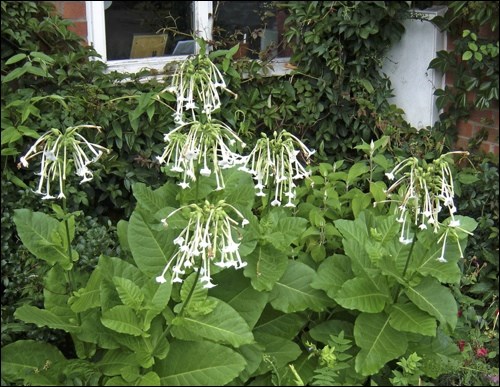My tobacco addiction to date has been limited to the closely related flowering types. How could one not fall in love with these (mostly) tall, stately plants with a quiet understated garden presence? The icing on the cake is their evening fragrance and magnetism for hummingbirds and butterflies.
John Nicot (1530-1600), namesake for the genus, first introduced tobacco to France from their native South America. Several flowering tobacco species are available to prairie gardeners as annuals. Most are easily grown from seed. Selections vary in height from one to six feet. Plant in full sun to partial shade. The strong stems seldom need staking unless they are very tall. Flowers come into their own in mid to late summer and continue until hard frost. Like their addictive relative, all parts are poisonous. All are moderately drought tolerant once established. You may find that some plants self-seed but are easily controlled.
Depending on their height, plant toward the middle or back of the border or near a porch or patio to enjoy their fragrance. They make a good cut flower. The white and yellow types are wonderful in a night garden both for their colour and fragrance.
Among the species and their cultivars are:
Lime tobacco (N. langsdorffi) has lime green flowers on well-branched plants, two to three feet tall.
Brazilian flowering tobacco (N. mutabilis), is native to Brazil and was introduced to North America only in the last decade. It reaches four to six feet high with branching stems. The unique flowers open white, mature to pale pink and then fade to a rose pink. This one is a hummingbird magnet!
Flowering tobacco hybrids (N. sanderae hybrids and N. alata x N. forgetianna) are generally shorter (one to three feet) available in red, pink, purple, green and white and emit an evening fragrance. The Avalon series includes Avalon Lime, Purple Bicolor and Pink Picotee.
These are dwarf compact plants of eight to 12 inches tall. Lime Green has lime sherbet blooms on 12 inch tall plants. Nicki mixed (14 to 16 inches) are well-branched plants in red, white, pink and purple. The Perfume series (14 to 16 inches) includes white, bright rose, red, deep purple, blue, lime and antique lime. These have, as the series name suggests, been selected for their evening fragrance and long bloom period. The Saratoga series has a wide range of colors on very uniform plants of 10 to 12 inches.
White shooting star (N. sylvestris) is a perennial in milder climes, but here we treat it as an annual. The species name, sylvestris, means of the woods, referring to its native habitat. Like the smoking tobacco type, the large, wavy, hairy leaves are lyre-shaped. The fragrant, tubular, white flowers are borne in drooping, loose panicles and resemble shooting stars or fireworks. Plants range from three to six feet in height and are strongly branched, with stems becoming woody toward the end of the season. Little breeding work has been done; however the species itself remains a great garden plant. Only the Lonely is a seed strain that has such a presence that you may need only one to make an impression. The large five to six inch tubular flowers are white.
Sara William is author of the recently expanded and revised Creating the Prairie Xeriscape and with Hugh Skinner of Gardening Naturally, A Chemical-free handbook for the Prairie.
— This column is provided courtesy of the Saskatchewan Perennial Society (www.saskperennial.ca; hortscene@yahoo.com; www.facebook.com/saskperennial). Check out our Bulletin Board or Calendar for upcoming garden information sessions, workshops, tours and other events: July 22-23 – Annual Lily Show (Canadian Prairie Lily Society, www.prairielily.ca); July 23 – Passport Garden Tour (Saskatoon Horticulture Society, HYPERLINK "http://www.saskatoonhortsociety.ca" www.saskatoonhortsociety.ca). GardenLine is back for the season to help solve your gardening glitches. FREE. Phone (306) 966-5865 or email gardenline@usask.ca.



